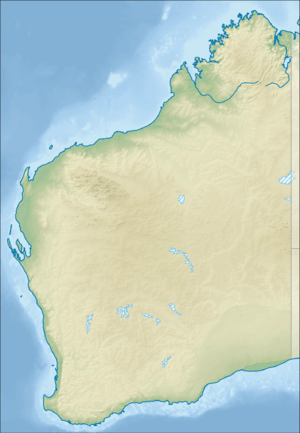RAAF Base Learmonth facts for kids
Quick facts for kids RAAF Base Learmonth |
|||||||
|---|---|---|---|---|---|---|---|
| Near Exmouth, Western Australia in Australia | |||||||
|
Location in Western Australia
|
|||||||
| Coordinates | 22°14′09″S 114°05′19″E / 22.23583°S 114.08861°E | ||||||
| Type | Military air base | ||||||
| Site information | |||||||
| Owner | Department of Defence | ||||||
| Operator | |||||||
| Site history | |||||||
| In use | circa 1950s – present | ||||||
| Garrison information | |||||||
| Occupants | 'Bare base' | ||||||
| Airfield information | |||||||
| Identifiers | IATA: LEA, ICAO: YPLM | ||||||
| Elevation | 6 metres (19 ft) AMSL | ||||||
|
|||||||
RAAF Base Learmonth, also known as Learmonth Airport, is a special place. It is used by both the Royal Australian Air Force (RAAF) and for regular civilian flights. This base is located near the town of Exmouth on the north-west coast of Western Australia.
RAAF Base Learmonth is one of the RAAF's three "bare bases." This means it has the main things needed for an air force base, like runways and buildings, but it doesn't have many people or planes there all the time. A small team from the RAAF's 25 Squadron looks after it during peacetime. This way, it can be quickly made ready if it's ever needed for a big operation.
The RAAF also uses the Learmonth Air Weapons Range. This is a large area, about 18,954 hectares (that's like 189 square kilometers!), located about 30 kilometers south-west of the air base. It's used for training with weapons.
Contents
History of RAAF Learmonth
Early Days: World War II and "Potshot"
During World War II, a secret landing field was built on the western shore of Exmouth Gulf. It was given the code-name "Potshot". A special RAAF unit, No. 76 Operational Base Unit, helped keep it running. This was all part of a bigger plan called "Operation Potshot."
In the 1950s, this landing field was made much bigger and better. It became a full military base and was named RAAF Learmonth. It was named after Wing Commander Charles Learmonth. He was a brave pilot who had won the DFC award twice. Sadly, he died in a flying accident in 1944 while leading his squadron.
Qantas and the "Kangaroo Service"
Starting in June 1944, the airline Qantas began using Learmonth. They used two special planes, which were originally Liberator bombers, to fly a very important route. This route was part of the journey from England to Australia. It helped to support another long flight route called "The Double Sunrise" which went to Ceylon.
The Liberator planes flew a shorter route from Learmonth to an airfield near Colombo in Sri Lanka. This flight was about 3,077 kilometers long and took about 17 hours. These planes could carry more cargo than the older planes.
This new route was called the Kangaroo Service. It was the first time Qantas used its famous kangaroo logo! Passengers on these flights received a special certificate. It said they were members of The Order of the Longest Hop. Qantas used the base again much later, during an emergency landing of Qantas Flight 72.
Developing Learmonth as a "Bare Base"
In the mid-1960s, the Australian Government decided to make Learmonth even more important. The head of the Air Force, Air Marshal Valston Hancock, wanted to redevelop it as a "bare base." This was because it was close to Indonesia.
Even though other planes, like the F-111C, could fly to Indonesia's capital, Jakarta, from RAAF Base Darwin, the route would have been very limited. Learmonth's location gave planes more options for flying in and out. This made it more likely that missions would be successful.
A lot of the construction work was done by the RAAF's No. 5 Airfield Construction Squadron. They worked on the base between 1971 and 1973.
Recent Civilian Flights
In October 2022, Qantas announced new flights. For the first time, they would offer direct flights between Melbourne and Exmouth. These flights started in April 2023 and run until October 2023. This makes it easier for people to visit the Exmouth area.


